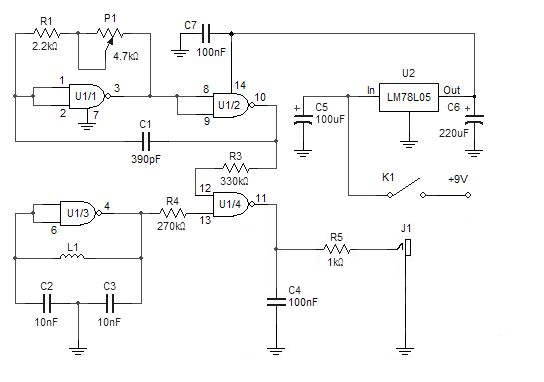"I'm intrigued with the idea of an electromagnetic style theremin..where you have a loop coil as the antenna and you have a metal on or in your hand and you approach this loop (with beringed fingers perhaps)to change the tone." - IJ
Yeah, it is fun to play with circuits and attempt to adapt them - can be a great way to learn..
But if it is a theremin one wants, the metal detector route is, IMO, a waste of time.
The thing which makes the theremin great is the capacitive sensing - there is no need for any 'actuators' (metal objects held in the hand, rings on fingers, leds, reflective strips - whatever), and one, by subtle changes to the hand (finger movements etc) gets subtle changes in pitch.
Every other method imposes limitations or reduces the options for the player. An optical sensor, for example, senses only a single 'point' or 'distance' - fingering is not recognised in the same way as it is with capacitive sensing.. and similar would be true for any metal detection scheme.. even if one had a ring on every finger, these would still be a limited set of points by which the pitch could be 'computed'.
Many, many years ago I played with metal detector schemes (long before I discovered the theremin - probably about 30+ years ago) - I did something like this once - a "trombone" ? - cant remember how it performed though! ;-)

Oh yes - Christophers comment about the capacitor on the regulator is spot on - its the kind of thing one learns to look for.. Seeing a bodge loke this doesnt always mean the rest of the circuit is crap (people have areas of weakness in their designs, and PSU design is often one of these) - but it does blink a red warning LED! (however, the circuit still doesnt look as nearly as crap as the Glasgow 'didital' theremin, LOL! ;-)
Fred.
Edit -> Dont trust this circuit!
C4 connected direct to ground from output of gate shows that the 'designer' doesnt even understand loading or rc filters! - as in, the design is crap!
IMO, you have found one above average circuit - this being the 4069 theremin. If you want a metal detector, I would use that circuit, and simply replace the transformer with a loop coil and seperate parrallell capacitor (no antenna).. you need the coil to have an inductance of 680uH if you use a 180pF capacitor - but as you can change the value of the capacitor (its not fixed inside the IFT) you can change the coil to taste and add whatever capacitance is required. You could even play with combining capacitive and inductive sensing perhaps..


